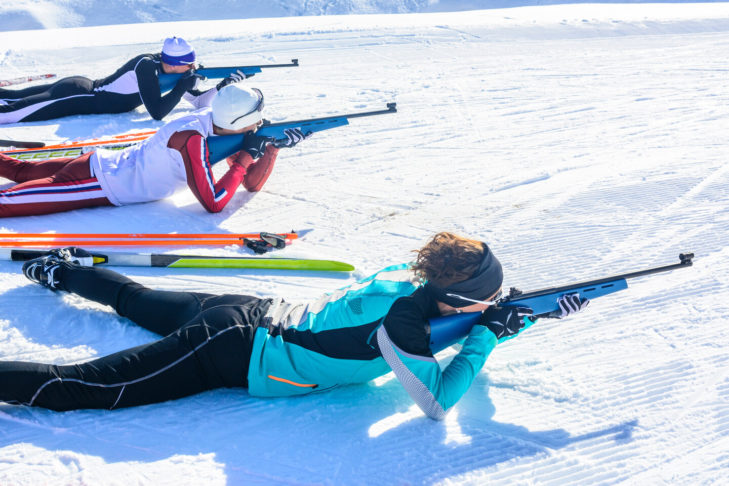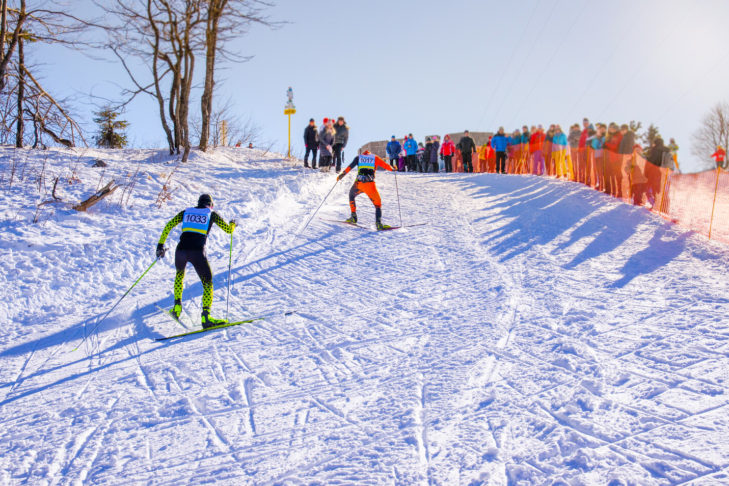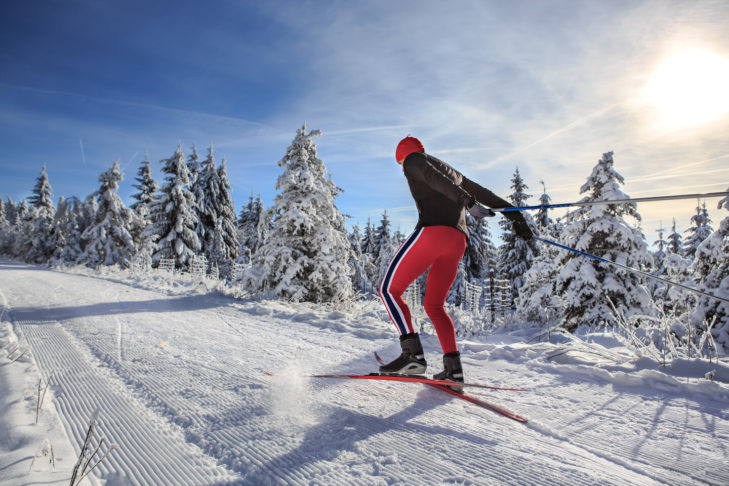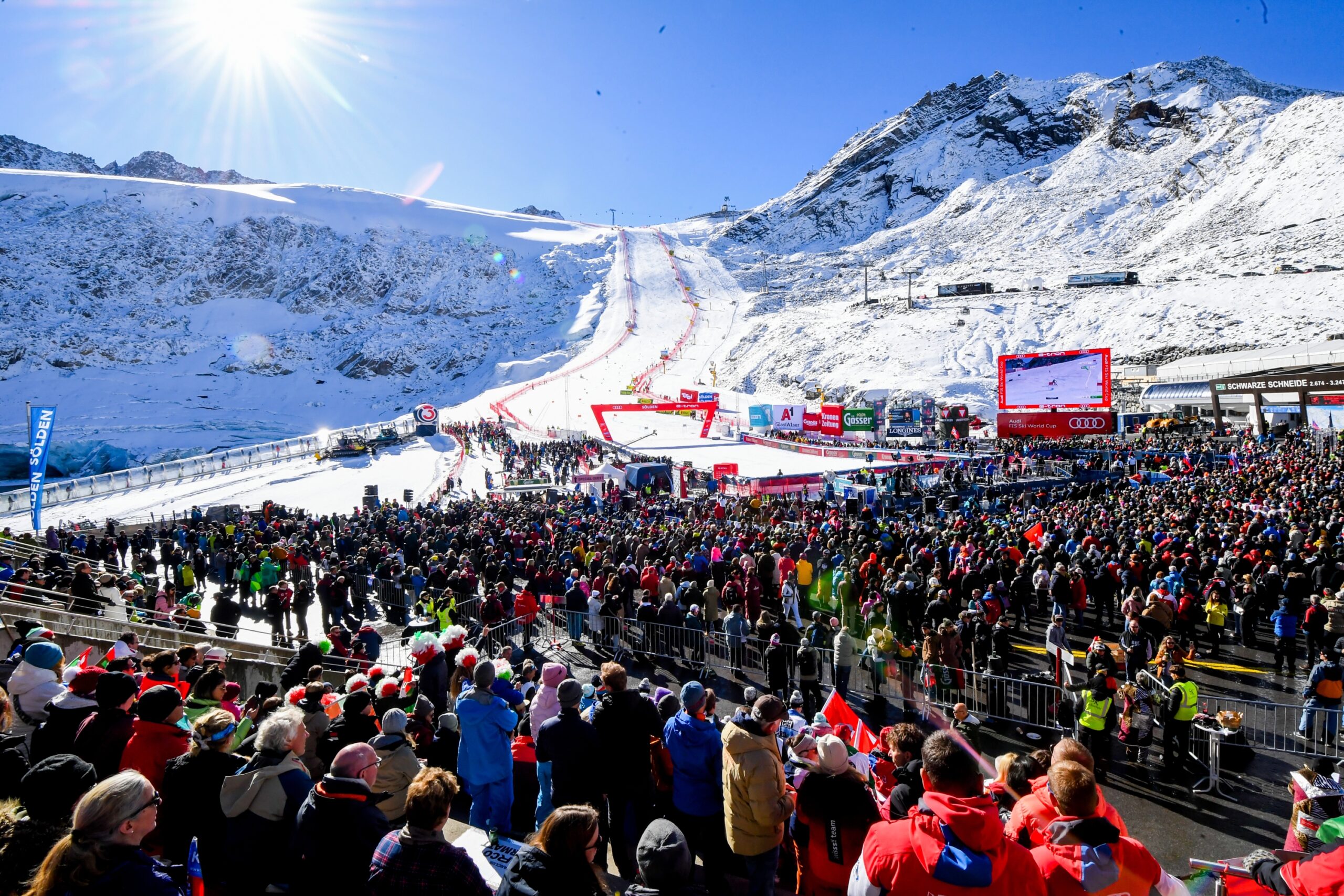Biathlon is one of the best-known and most popular winter sports worldwide. Many winter fans are fascinated by the sport that combines endurance and precision in such a unique way and follow the competitions eagerly, in which the athletes outdo each other year after year with outstanding performances. SnowTrex has compiled 10 facts about the biathlon and shows what excites so many winter fans about this unique sport.
1. What is biathlon?
Biathlon is a sport that is mainly practised in winter and has its origins in hunting. The term “biathlon” comes from the Greek and means “duel”. The “two” does not refer to the athletes, but to the two disciplines performed: cross-country skiing and shooting. Biathlon thus combines an endurance discipline with a precision discipline, and demands a special range of skills from the athletes due to this unique combination.
2. History of biathlon
The sport of biathlon developed over thousands of years. Norwegian cave paintings indicate that people were already using skis as a tool for tracking wild animals in the snow over 5,000 years ago. An illustration from 1050 AD showed a hunting man with bow and arrow on skis, which can be interpreted as the precursor of today’s biathlon.
The origin of today’s biathlon sport with its combination of shooting with a rifle and cross-country skiing lies in the military sphere. Over centuries, the sport spread from the Norwegian and Russian militaries to all countries that had to deal with a lot of snow in winter.
After the Second World War, the combination sport was demilitarized and biathlon was increasingly accepted and promoted as a civilian sport. In 1954, the International Olympic Committee recognized biathlon as a sport in its own right and in 1958 the first World Championships were held in Saalfelden, Austria. The sport then made Olympic history in 1960 at the Palisades Tahoe ski resort. At that time, the ski area was still called Squaw Valley Ski Resort. Until then, the competitions were only for men, and it was not until 1981 that the first international women’s competition took place in Jáchymov, then in Czechoslovakia. The first Biathlon World Championships for women were held in 1984, at that time still separately from the men. Since 1989, the World Championships have been held across the genders on one date. Since 1992 in Albertville, biathlon has also been an Olympic discipline for women.
Today, biathlon is one of the best-known winter sports and is the third most popular TV sport in Germany after football and Formula 1. One of the reasons for this is the combination of cross-country skiing and shooting, which makes this winter sport so unique and keeps the tension until the end of the race. In addition, of course, the athletes who shine in winter with records and spectacular victories while continuing to write biathlon history are also fascinating.
3. Disciplines in biathlon
There are various disciplines in the sport of biathlon, which all follow the same basic principle, namely the combination of cross-country skiing and shooting. The biathlon disciplines differ from each other in terms of rules, distances, and number of participants. Currently, these seven disciplines are held in the Biathlon World Cup and at the World Championships: individual, sprint, pursuit, mass start, relay, mixed relay and the single-mixed relay. At the Olympic Games, the same disciplines are on the programme, except for the single-mixed relay.
SnowTrex has had a closer look at the biathlon disciplines here.
4. Biathlon equipment
A biathlete’s equipment includes many special items. The basic items are the suit, the right ski goggles, warm gloves and a cap to protect the ears. Of course, the rifle and the right skis and ski poles are also essential.
The first main component of the biathlon equipment is the equipment needed for cross-country skiing. This includes, of course, the cross-country ski. Since athletes primarily use the skating technique, this is usually a skating ski weighing about 1.2 kg and about 5 cm wide. The length of the ski depends on the size of the athlete and is not limited. Another important part of the equipment are the cross-country ski boots, which are fixed with a binding approximately in the middle of the ski. To give the athletes a better push, they can lift the back part of the boot off the ski with each step. The skis and boots are complemented by cross-country poles. These are about shoulder-high, measured against the size of the biathlete, and guarantee that the athletes can push off optimally in the snow.
The second main component of the equipment is the rifle, for which the athletes need a firearms licence. It is specified that the rifle is a small calibre rifle and weighs between 3.8 and 4.5 kg. By the way, the rifles are checked by the judges before each competition… safety first. The athletes are given some leeway regarding some details of the rifle. Among other things, they can choose the size, material, and texture of the stock and have compartments for tools or spare ammunition built into their rifles.
There are also certain specifications for the ammunition. For example, the projectiles must have a calibre of .22 lr (5.6 mm). In addition, the bullet must weigh between 2.55 and 2.75 grams and have a maximum muzzle velocity of 360 m/s. The ammunition is also specially adapted to low temperatures. Incidentally, the ammunition is specially adapted for use at low temperatures.
In addition to their clothing and cross-country skiing equipment, the biathletes have a rifle weighing about 4 kg, which they have to carry along with the ammunition in a carrying system on their backs during the competition.
5. Biathlon competitions
In biathlon, there are many competitions for different age groups and performance levels. The most well-known competitions are the international competitions of the professional women and men. These are the Winter Olympics, the Biathlon World Championships and the Biathlon World Cup.
The Biathlon World Cup is the highest level of competition in biathlon and extends over an entire winter. The World Cup is usually held at nine World Cup venues, with races organized by the Biathlon World Federation (IBU). At each race, the athletes try to collect World Cup points. At the end of the season, all points are added up and the biathlete with the most World Cup points wins the overall World Cup ranking. In addition, since 1989 there has also been a classification in the individual disciplines, which determines the winner of the season in the respective discipline.
At the end of the past competition series, the World Federation presented the best pictures of the season here:
Please also note that by using our services and integrating the YouTube API Services, the YouTube Terms of Service and the YouTube API Services Terms apply and your use of our website is deemed to be acceptance of these terms.
Biathlon has been part of the official Olympic programme since 1960, when a 20 km race was held, and since then biathlon competitions have been held every four years at the Winter Olympics. In 2018 in Pyeongchang, 33 medals were awarded in eleven races in various disciplines, making biathlon one of the Olympic sports with the most competitions.
The Biathlon World Championships for men have been held in all non-Olympic years since 1958 and for women since 1984. The World Championships races usually take place over two weeks in February or March and are part of the Biathlon World Cup.
6. Cross-country skiing
The first discipline of the combination sport biathlon is cross-country skiing. Depending on the discipline, biathletes have a distance of 3 to 20 km that they have to cover within one race using optimized skiing technique. The skating technique has been established since the 1980s and is used almost exclusively today.
With this technique, the athletes push themselves off the ground with one ski and the poles and glide forward on the other ski – similar to inline skating or ice skating. Depending on the course conditions and the competition situation, athletes use four basic techniques or rhythms of the skating technique: 2-1-short, 2-1-long, 1-1 and a pole-less technique. But what exactly do the names of the techniques mean? An exemplary explanation of the 2-1-short technique: In the 2-1-short technique, also called leading arm technique or mountain step, the “2-1” refers to two leg push-offs supported by only one double pole push with the arms. The technique is comparatively slow, but particularly effective on steeply sloping terrain. The “short” refers to the rather short gliding phase on ascending terrain.
All four rhythms are extremely strenuous and use almost all the muscles of the body. Only the best athletes in the sport manage to control the body between the endurance effort in the short phases at the shooting range so that precise shooting is possible.
7. Shooting
Shooting is the precision discipline of the biathlon, where the athletes have to concentrate and focus particularly hard.
Shooting is done at least once lying down and once standing up, depending on the discipline. There are 30 shooting lines at the shooting range, from which the athletes can choose one during the competition, unless the competition order is fixed. There are five targets exactly 50 m away from the athletes, with a diameter of 4.5 cm (prone shooting) or 11.5 cm (standing shooting), depending on the athlete’s position. If the biathlete shoots and hits, a black target moves in front of the white target. If the athlete fails to hit the target, he/she has to do a penalty lap of 150 m or 75 m for each missed shot, depending on the biathlon discipline, or he/she is given a penalty minute.
The goal of every biathlete is to hit all five targets quickly during shooting in order to lose as little time as possible and to be able to return to the track immediately.
8. Famous biathlon athletes and their records
The most famous athletes in the sport of biathlon are mainly the male and female biathletes with the most successes and medals. Since biathletes usually compete in several, and often all, disciplines of their sport, the most recognized records are those that represent the most gold medals in one of the three major competitions.
The Norwegian Ole Einar Bjørndalen is considered the most successful biathlete of all time. He competed in international biathlon competitions for over 25 years. During this time, he played at the top of the professional competitions for no less than 20 years. The celebrity won eight gold medals at the Winter Olympics and managed to secure 20 gold medals within World Championships. Bjørndalen thus went down in history as the record holder for the most gold medals in no less than two of the most important biathlon competitions.
Martin Fourcade likewise became a biathlon celebrity after shining with outstanding performances for over ten years. He was the first biathlete to win the overall World Cup seven times in a row. In addition, the Frenchman was able to record 15 more World Cup medals and seven Olympic podium finishes.
A famous and very successful biathlete is Magdalena Neuner. She was active in professional biathlon competitions between 2006 and 2012 and celebrated a total of 47 World Cup victories during this time. In addition, the German won gold twice at the Olympics and secured the women’s record for the most gold world championship titles with a total of twelve gold medals.
Two other icons of the biathlon are biathletes Darja Domratcheva and Magdalena Forsberg. The former is the wife of Ole Einar Bjørndalen and, like her husband, is the record holder for the most gold medals won by a biathlete at the Olympics. The Belarusian was able to win the gold in the individual, pursuit, mass start and relay between 2014 and 2018. Magdalena Forsberg is the third woman to hold a record for the most gold medals in one of the three major competitions. The Swede was the sport’s dominant athlete between 1997 and 2002. During this time, she was able to set the undisputed record of six overall World Cup victories in a row in the women’s event. She is also a six-time World Champion and brought home two bronze medals at the 2002 Winter Olympics in Salt Lake City.
Other names you should have heard if you are a fan of the German biathlon world: Laura Dahlmeier, Arnd Pfeiffer, Erik Lesser, Marina Glagow, Kati Wilhelm, Andrea Henkel, Uschi Disl, Frank Ullrich, Ricco Groß, Raphaël Poirée, Sven Fischer, Michael Greis, Peter Angerer.
9. Events
The competitions in the biathlon all take place in winter. Depending on which competitions are held in a season, the International Biathlon Union (IBU) sets the dates and venues for the World Championships and the World Cup.
For the World Cup, a total of 22 individual races and four races for each relay have to be held per season between the end of November and the end of March. The races are held at nine different World Cup venues. In all non-Olympic years, one World Cup station is also the World Championships, which take place over two weeks in February or March.
As part of the Winter Olympics, the biathlon competitions are held in February every four years.
10. Popular biathlon destinations
Many ski resorts in the Alps have cross-country trails where winter fans can train for the cross-country part of the biathlon as part of a course or on their own. Many regions such as the Austrian Olympic region of Seefeld, the Auvergne-Rhône-Alpes region in France, the Swiss Engadin and the Oberhof holiday region in Germany are true strongholds of cross-country skiing. The absolute cross-country skiing paradise of the Alps is definitely the region of the Italian Dolomites, with no less than around 1,300 kilometres of trails.
Shooting is of course also very attractive for amateur biathletes. This can only be practised at shooting ranges, which are usually located in biathlon stadiums. For beginners, there are workshops where experienced biathletes teach them the basics of the combination sport. Biathlon workshops are offered in winter paradises such as Garmisch-Partenkirchen in Bavaria, Oberhof in Thuringia, Hochfilzen in Austria and the ski resort of Arosa-Lenzerheide in Switzerland.
Curious winter enthusiasts and also experienced recreational biathletes thus have a wide choice of destinations where they can try out, practise, train, and perfect their biathlon skills.
Fancy more alternative sports to alpine skiing and snowboarding? Click here for an overview of alternatives.
FAQs about Biathlon
What is Biathlon?
Biathlon is a winter sport that consists of cross-country skiing and shooting. The sport combines endurance and precision in seven different disciplines and demands a special range of skills from the athletes.
Where does the term “biathlon” come from?
The term “biathlon” comes from the Greek and means “duel”. The “two” refers to the two disciplines performed: cross-country skiing and shooting.
When did the first Biathlon World Championship take place?
The first men’s biathlon world championship was held in 1958 in Saalfelden, Austria. The women were allowed to compete in a biathlon world championship for the first time in 1984 in Chamonix. Since 1989, the World Championships have been organized on a cross-gender and simultaneous basis.
When did biathlon become Olympic?
Biathlon was recognized as an independent sport by the International Olympic Committee in 1954. The sport was first included on the programme of the 1960 Winter Olympics in Squaw Valley. Women were able to compete in Olympic biathlon events for the first time in 1992 in Albertville.
What disciplines are there in the biathlon?
Within the Biathlon World Cup and the World Championships there are currently seven disciplines: individual, sprint, pursuit, mass start, relay, mixed relay and the single-mixed relay. Only at the Olympic Games is there one discipline, the single-mixed relay, which is not part of the World Championships and also of the World Cup.
What belongs to the biathlon equipment?
A biathlete’s equipment includes many special items: biathletes need the right clothing, sports goggles, cross-country skis, cross-country boots and cross-country poles. For shooting, athletes also require a rifle and ammunition, as well as a carrying system to carry the rifle on their back while cross-country skiing.
How often do you shoot in the biathlon?
How often biathletes shoot within a competition depends on the discipline. In the sprint, in the qualification for the super sprint and within all relays, the athletes go to the shooting range twice. In all other disciplines, they pass the shooting range four times. When the athletes are at the shooting range, they have to hit five targets, regardless of the discipline.
How long is the penalty loop in the biathlon?
If an athlete misses a target in shooting, he or she has to complete a penalty loop in almost all disciplines. The penalty loop is 150 m long, or 75 m in the super sprint and in the single-mixed relay, and is located in the immediate vicinity of the shooting range. Only in the individual race, the penalty for a miss is not a penalty lap, but a penalty time of one minute.
What are the competitions in the biathlon?
The best-known and most important competitions in the biathlon are the international competitions of the professionals. These include the Biathlon World Cup, the Winter Olympics and the Biathlon World Championships.
Where can you try biathlon?
In most biathlon stadiums, curious winter fans can try out the winter sport. Biathlon workshops are usually offered to teach beginners the basics of shooting and cross-country skiing. These workshops are offered in the German destinations of Garmisch-Partenkirchen and Oberhof, the Austrian town of Hochfilzen and the ski resort of Arosa-Lenzerheide in Switzerland, among others.







